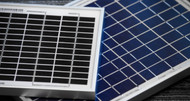DIFFERENCE BETWEEN A MONOCRYSTALLINE AND POLYCRYSTALLINE SOLAR PANEL
25th Feb 2022
One of the frequently asked questions when it comes to solar panels has always been:
What is the difference between a Monocrystalline and Polycrystalline solar panel?
What Do Monocrystalline Panels Look Like?
You can easily recognize monocrystalline solar cells by their uniform and dark appearance along with their rounded edges containing small spaces between each cell. Pure silicon ingots are naturally round, so slicing them results in square wafers with rounded edges. This creates small gaps between the cells once assembled, and because they’re composed of pure silicon, they appear darker because of how light interacts with the material.
What Do Polycrystalline Solar Panels Look Like?
Unlike the darkened uniform look that the monocrystalline solar cells have, polycrystalline cells tend to have a blue hue because of how sunlight interacts with the multi-crystalline cells. Moreover, because polycrystalline wafers aren’t cut from cylinders like their counterparts, they don’t have rounded edges. Therefore, you can easily recognize a polycrystalline panel by the blueish hue and the absence of rounded edges. Furthermore, polycrystalline cells have the option of adding colorful back sheets and frame designs to suit your needs, or better yet, even match your roof.

Efficiency of Monocrystalline vs Polycrystalline Solar Panels
The efficiency of a solar panel is an indicator of how well the cell performs at converting sunlight into electricity. For example, if we examined the two types of solar panels, one with an efficiency of 10% and the other with an efficiency of 20%, and we shine the same amount of light for the same period, the latter will produce almost double the electricity generated by the first one. This is primarily because monocrystalline panels have a higher efficiency rating and produce more power per square foot when compared to polycrystalline panels.
How Efficient are Monocrystalline Solar Panels?
Among different solar panel types available, monocrystalline cells provide the highest efficiency ratings, typically ranging between 15-20% and are expected to increase even more.
Fun fact: In 2019, the National Renewable Energy Laboratory managed to develop a six-junction solar cell with an efficiency of 47.1%, setting 2 new world records.
How Efficient are Polycrystalline Solar Panels?
Since each polycrystalline cell is made up of several crystals, there is less room for electrons to move around, resulting in lowered electricity generation. Although monocrystalline panels have higher efficiency ratings, the difference between them and polycrystalline cells isn’t massive. Most polycrystalline PV cells have efficiencies between 13% to 16%, which is still a very good ratio and is only expected to increase in the future.

How Temperature Affects Monocrystalline Solar Panels Efficiency?
Most monocrystalline solar cells have a temperature coefficient of around -0.3% / C to -0.5% / C. When the temperature rises 1 degree Celsius or 32 degrees Fahrenheit, the monocrystalline solar cell will temporarily lose 0.3% to 0.5% of its efficiency as a result.
How Does Temperature Affect Polycrystalline Solar Panel Efficiency?
Polycrystalline PV cells have a higher temperature coefficient than the monocrystalline ones. This means that polycrystalline panels will lose more of their efficiency under increasing temperatures, making them least optimal for use in areas with high temperatures.

Expected Lifespan
The lifespan of the solar cell is indicated by the degradation rate or the yearly energy production loss. Most solar panels have a degradation rate of 0.3% to 1%. This means that every year, the total power output of your system will decrease by 0.3% to 1%. Most monocrystalline PV panels have a yearly efficiency loss of 0.3% to 0.8%.
For example, let’s assume we have a monocrystalline solar panel with a degradation rate of 0.5%. This means that in 10 years, the system will operate at 95% efficiency, in 20 years, the system will operate at 90% efficiency, and so on. This pattern continues until it loses a significant amount of its energy production capability, eventually making it inefficient.
Most monocrystalline solar panels come with a 25- or 30-year warranty period. However, you can easily expect your system to last for up to 40 years or more.

How Long Do Polycrystalline Solar Panels Last?
Polycrystalline PV cells have a slightly higher degradation rate than, which causes them to lose their efficiency a little faster when compared to the monocrystalline ones. Nonetheless, most polycrystalline panels come with a 20–35-year warranty period and sometimes even more.

We really hope you enjoyed this article! Did you find this guide helpful?
If so, please share this article with your friends and let us know your thoughts.
